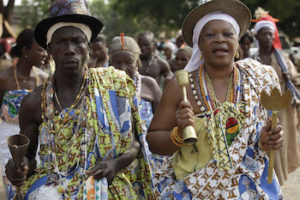
*The Fon People were celebrated on this date in 1000. They are the largest ethnic group in Benin, particularly in its south region; they are also found in southwest Nigeria and Togo.
Also called Fon nu, Agadja, or Dahomey, they are part of the Gbe ethnic community. Their population is estimated to be approximately 3.5 million people, and they speak the Fon language, a member of the Gbe language family. The history of the Fon people is closely tied to the Dahomey kingdom, a well-organized state by the 17th century, but one that shared more ancient roots with the Aja people. The Fon people traditionally have a culture rooted in oral tradition and a well-developed polytheistic religious system. Early 19th-century European traders noted their practice within the Kingdom of Dahomey, which empowered women to serve in the military and fight against French colonial forces in 1890.
Cities built by the Fon include Abomey, the historical capital city of Dahomey, on what was historically referred to by Europeans as the Slave Coast. These cities became major commercial centers for the Middle Passage. A significant portion of the sugar plantations in the French West Indies, particularly Haiti and Trinidad, were populated with slaves who came from the Slave Coast through the lands of the Ewe and Fon people. The Fon people, like other neighboring ethnic groups in West Africa, remained without ancient historical records. According to their oral histories and legends, the Fon people originated in present-day Tado, a small Aja town near the Togo-Benin border.
To the city of Abomey, where the kingdom of Dahomey was founded sometime around 1620 CE. The Fon people have been settled there since, while the kingdom of Dahomey expanded in southeast Benin by conquering neighboring kingdoms. The Fon people have traditionally settled as farmers, cultivating staples such as cassava, corn, and yams. The men prepare the fields, and the women tend and harvest the crops. Hunting and fishing are additional food sources, while some members of the Fon society create pottery, weave clothing, and produce metal utensils. Among the cash crops, palm oil plantations are prevalent in the region inhabited by the Fon people.
The Fon culture is patrilineal and allows polygyny and divorce. A man with multiple wives typically lived in a compound, with each wife and her children residing in a separate hut. A collection of compounds formed a village, usually headed by a hereditary chief. In contemporary times, traditional patrilineal clan-based living and associated practices are uncommon. Funerals and death anniversaries to remember loved ones are important events, often accompanied by drumming and dancing as a form of mourning and celebrating the start of life as a spirit by the one who has passed away, which can last for days. The Fon culture incorporated culture and shared ideas with ethnic groups that have been their historic neighbors. Many of their practices are found among Yoruba people, Akan people, Ewe people, and others.
A notable aspect of the Fon people's society was their use of female soldiers in combat roles for over two centuries. Over 3,000 women trained and served as regular warriors to protect the Fon and expand its reach. Called the Dahomey Amazons, the brigade was led by women. Given the oral tradition of the Fon people, it is unclear when women joined as warriors in Fon society. The earliest European records, such as those of Jean-Pierre Thibault, suggest that the tradition dates back to the early 18th century. These gender roles were foreign to European travelers, and many scholars consider early fictional stories in European media unreliable. Most Fon today reside in villages and small towns in mud houses with corrugated iron gable roofs.